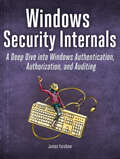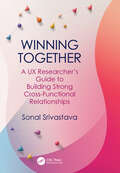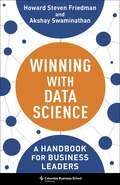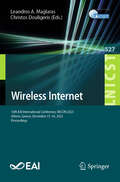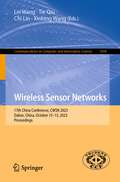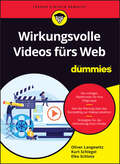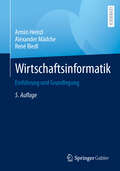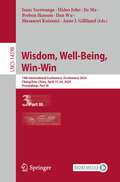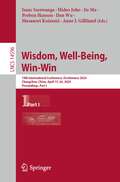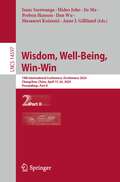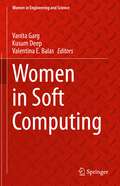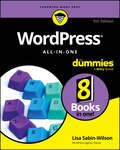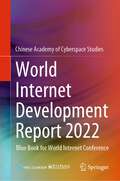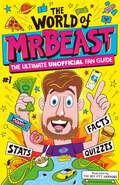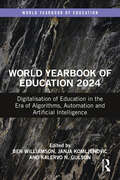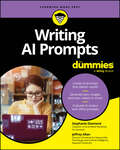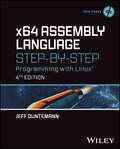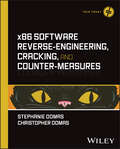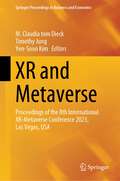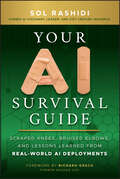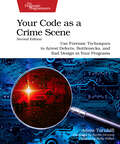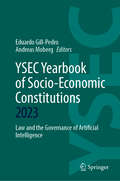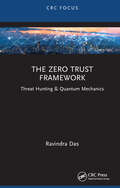- Table View
- List View
Windows Security Internals: A Deep Dive into Windows Authentication, Authorization, and Auditing
by James ForshawPower up your Windows security skills with expert guidance, in-depth technical insights, and dozens of real-world vulnerability examples from Google Project Zero&’s most renowned researcher! Learn core components of the system in greater depth than ever before, and gain hands-on experience probing advanced Microsoft security systems with the added benefit of PowerShell scripts.Windows Security Internals is a must-have for anyone needing to understand the Windows operating system&’s low-level implementations, whether to discover new vulnerabilities or protect against known ones. Developers, devops, and security researchers will all find unparalleled insight into the operating system&’s key elements and weaknesses, surpassing even Microsoft&’s official documentation.Author James Forshaw teaches through meticulously crafted PowerShell examples that can be experimented with and modified, covering everything from basic resource security analysis to advanced techniques like using network authentication. The examples will help you actively test and manipulate system behaviors, learn how Windows secures files and the registry, re-create from scratch how the system grants access to a resource, learn how Windows implements authentication both locally and over a network, and much more.You&’ll also explore a wide range of topics, such as:Windows security architecture, including both the kernel and user-mode applicationsThe Windows Security Reference Monitor (SRM), including access tokens, querying and setting a resource&’s security descriptor, and access checking and auditingInteractive Windows authentication and credential storage in the Security Account Manager (SAM) and Active DirectoryMechanisms of network authentication protocols, including NTLM and KerberosIn an era of sophisticated cyberattacks on Windows networks, mastering the operating system&’s complex security mechanisms is more crucial than ever. Whether you&’re defending against the latest cyber threats or delving into the intricacies of Windows security architecture, you&’ll find Windows Security Internals indispensable in your efforts to navigate the complexities of today&’s cybersecurity landscape.
Winning Together: A UX Researcher's Guide to Building Strong Cross-Functional Relationships
by Sonal SrivastavaUX research, the key to comprehending users' behaviors, motivations, and preferences for developing delightful experiences, thrives on effective teamwork and collaboration. This comprehensive guide brings together the expertise and insights from seasoned researchers, cross-functional partners, and product leaders in order to transform how you collaborate and unlock the true potential of UX research. Key Features Includes a comprehensive selection of ready-to-use templates Incorporates insights and advice from cross-functional stakeholders Offers a wide range of strategies tailored to various expertise levels, catering to both novice and advanced practitioners Presents universally applicable methodologies and insights, equipping a diverse range of researchers, including consultants, vendors, and in-house professionals From experienced professionals to those just starting out, and freelancers to in-house researchers, this comprehensive guide offers practical strategies to navigate the pitfalls of UX research, enhancing collaboration and, ultimately, driving success.
Winning with Data Science: A Handbook for Business Leaders
by Howard Steven Friedman Akshay SwaminathanWhether you are a newly minted MBA or a project manager at a Fortune 500 company, data science will play a major role in your career. Knowing how to communicate effectively with data scientists in order to obtain maximum value from their expertise is essential. This book is a compelling and comprehensive guide to data science, emphasizing its real-world business applications and focusing on how to collaborate productively with data science teams.Taking an engaging narrative approach, Winning with Data Science covers the fundamental concepts without getting bogged down in complex equations or programming languages. It provides clear explanations of key terms, tools, and techniques, illustrated through practical examples. The book follows the stories of Kamala and Steve, two professionals who need to collaborate with data science teams to achieve their business goals. Howard Steven Friedman and Akshay Swaminathan walk readers through each step of managing a data science project, from understanding the different roles on a data science team to identifying the right software. They equip readers with critical questions to ask data analysts, statisticians, data scientists, and other technical experts to avoid wasting time and money. Winning with Data Science is a must-read for anyone who works with data science teams or is interested in the practical side of the subject.
Wireless Internet: 16th EAI International Conference, WiCON 2023, Athens, Greece, December 15-16, 2023, Proceedings (Lecture Notes of the Institute for Computer Sciences, Social Informatics and Telecommunications Engineering #527)
by Leandros A. Maglaras Christos DouligerisThis book constitutes the refereed post-conference proceedings of the 16th International Conference on Wireless Internet, WiCON 2023, held in Athens, Greece, in December 15-16, 2023. The 14 full papers were selected from 35 submissions and are grouped into the following topics: Wireless networks; AI/ML systems; 5G/6G networks; and Digital services.
Wireless Sensor Networks: 17th China Conference, CWSN 2023, Dalian, China, October 13–15, 2023, Proceedings (Communications in Computer and Information Science #1994)
by Lei Wang Tie Qiu Chi Lin Xinbing WangThis book constitutes the refereed proceedings of the 17th China Conference on Wireless Sensor Networks, CWSN 2023, which took place in Dalian, China, in October 2023. The 22 full papers presented in this volume were carefully reviewed and selected from 105 submissions, including 38 English papers and 67 Chinese papers. The conference provided an academic exchange of research and a development forum for IoT researchers, developers, enterprises, and users. Exchanging results and experience of research and applications in IoT, and discussing the key challenges and research hotspots, is the main goal of the forum. As a high-level forum for the design, implementation, and application of IoT, the conference promoted the exchange and application of the theories and technologies of IoT-related topics.
Wirkungsvolle Videos fürs Web für Dummies (Für Dummies)
by Oliver Langewitz Kurt Schlegel Elke SchloteMithilfe von Videos das Netz begeistern Videos bieten Ihnen die Möglichkeit, eigene Ideen zu vermitteln oder Ihre Marke zu präsentieren. Wie Sie wirkungsvolle Videos fürs Web erstellen und was Sie bei der videobasierten Kommunikation beachten müssen, erfahren Sie in diesem Buch. Oliver Langewitz, Kurt Schlegel und Elke Schlote erklären Ihnen in praktischen Schritten, wie Ihnen die Planung, Erstellung und Verbreitung von Videos fürs Web optimal gelingt. Dabei lernen Sie auch die Besonderheiten der verschiedenen Internetplattformen kennen und wie Sie Ihre Zielgruppe mit Ihren Inhalten abholen. Sie erfahren Wie Sie professionelle Webvideos produzieren Wie Sie in Ihren Videos wirksame Geschichten erzählen Welche Online-Kanäle für Ihre Videos wichtig sind Wie es Ihnen gelingt, mit Ihren Videos eine breite Community zu erreichen
Wirtschaftsinformatik: Einführung und Grundlegung
by Alexander Mädche René Riedl Armin HeinzlDas Lehrbuch führt systematisch und grundlegend in die Wirtschaftsinformatik ein und behandelt die grundlegenden Phänomene der Wirklichkeit, ohne deren Vorhandensein und große praktische Bedeutung die Wirtschaftsinformatik als Wissenschaft und als wissenschaftliches Studium nicht existieren würde. Es beschreibt den Gegenstandsbereich, den Wissenschaftscharakter und die Wissenschaftsaufgaben sowie die Methoden, die zur Erklärung und Gestaltung verfolgt und verwendet werden. Es zeigt sowohl Zweck und Ziele der Wirtschaftsinformatik als auch grundlegende Phänomene wie Information und Kommunikation, Typen von Informationssystemen, Informationsinfrastruktur sowie Digitalisierung und digitale Transformation. Zudem wird die Rolle des Menschen als zentrales Element von Informationssystemen dargestellt. Das Buch richtet sich an Studierende und Lehrende in grundständigen Bachelor- und Masterprogrammen. Auch Schüler und Praktiker können anhand der Lektüre neue Erkenntnisse gewinnen.
Wisdom, Well-Being, Win-Win: 19th International Conference, iConference 2024, Changchun, China, April 15–26, 2024, Proceedings, Part III (Lecture Notes in Computer Science #14598)
by Isaac Sserwanga Hideo Joho Jie Ma Preben Hansen Dan Wu Masanori Koizumi Anne J. GillilandThe Three-volume set LNCS 14596, 14597 and 14598 constitutes the proceedings of the 19th International Conference on Wisdom, Well-Being, Win-Win, iConference 2024, which was hosted virtually by University of Tsukuba, Japan and in presence by Jilin University, Changchun, China, during April 15–26, 2024. The 36 full papers and 55 short papers are presented in these proceedings were carefully reviewed and selected from 218 submissions. The papers are organized in the following topical sections: Volume I: Archives and Information Sustainability; Behavioural Research; AI and Machine Learning; Information Science and Data Science; Information and Digital Literacy. Volume II: Digital Humanities; Intellectual Property Issues; Social Media and Digital Networks; Disinformation and Misinformation; Libraries, Bibliometrics and Metadata. Volume III: Knowledge Management; Information Science Education; Information Governance and Ethics; Health Informatics; Human-AI Collaboration; Information Retrieval; Community Informatics; Scholarly, Communication and Open Access.
Wisdom, Well-Being, Win-Win: 19th International Conference, iConference 2024, Changchun, China, April 15–26, 2024, Proceedings, Part I (Lecture Notes in Computer Science #14596)
by Isaac Sserwanga Hideo Joho Jie Ma Preben Hansen Dan Wu Masanori Koizumi Anne J. GillilandThe Three-volume set LNCS 14596, 14596 and 14598 constitutes the proceedings of the 19th International Conference on Wisdom, Well-Being, Win-Win, iConference 2024, which was hosted virtually by University of Tsukuba, Japan and in presence by Jilin University, Changchun, China, during April 15–26, 2024. The 36 full papers and 55 short papers are presented in these proceedings were carefully reviewed and selected from 218 submissions. The papers are organized in the following topical sections: Volume I: Archives and Information Sustainability; Behavioural Research; AI and Machine Learning; Information Science and Data Science; Information and Digital Literacy. Volume II: Digital Humanities; Intellectual Property Issues; Social Media and Digital Networks; Disinformation and Misinformation; Libraries, Bibliometrics and Metadata. Volume III: Knowledge Management; Information Science Education; Information Governance and Ethics; Health Informatics; Human-AI Collaboration; Information Retrieval; Community Informatics; Scholarly, Communication and Open Access.
Wisdom, Well-Being, Win-Win: 19th International Conference, iConference 2024, Changchun, China, April 15–26, 2024, Proceedings, Part II (Lecture Notes in Computer Science #14597)
by Isaac Sserwanga Hideo Joho Jie Ma Preben Hansen Dan Wu Masanori Koizumi Anne J. GillilandThe Three-volume set LNCS 14596, 14596 and 14598 constitutes the proceedings of the 19th International Conference on Wisdom, Well-Being, Win-Win, iConference 2024, which was hosted virtually by University of Tsukuba, Japan and in presence by Jilin University, Changchun, China, during April 15–26, 2024. The 36 full papers and 55 short papers are presented in these proceedings were carefully reviewed and selected from 218 submissions. The papers are organized in the following topical sections: Volume I: Archives and Information Sustainability; Behavioural Research; AI and Machine Learning; Information Science and Data Science; Information and Digital Literacy. Volume II: Digital Humanities; Intellectual Property Issues; Social Media and Digital Networks; Disinformation and Misinformation; Libraries, Bibliometrics and Metadata. Volume III: Knowledge Management; Information Science Education; Information Governance and Ethics; Health Informatics; Human-AI Collaboration; Information Retrieval; Community Informatics; Scholarly, Communication and Open Access.
Women and Film Animation: A Feminist Corpus at the National Film Board of Canada 1939-1989
by Marie-Josée Saint-PierreThe creations of female animation filmmakers are recognized all over the world while being, paradoxically, unknown to the general public. Women and Film Animation: A Feminist Corpus at the National Film Board of Canada 1939-1989 brings out of the shadows the work of true pioneers by presenting and analyzing, from a resolutely feminist perspective, the works they have conceived within the National Film Board of Canada (NFB).This institution has played an essential role in the emergence of animated cinema in Canada, but it is forgotten or ignored that a good part of this vast corpus is the work of women who have worked there not only as assistants but also as directors. These artists have contributed to changing the traditional representations of women in a unique way in both commercial and avant-garde animated cinema. The author accounts for their concerns, their creativity, and their many bright achievements. To do this, she relies on a wide range of critical works in social and cultural history of Canada, in feminist art history, and on multiple studies on animated cinema.Key Features: Provides an interdisciplinary approach that combines concepts from feminist studies, film theory and visual arts for a nuanced analysis of the role of women in animated cinema Discusses historical and sociological background that sheds light on the condition of women Includes a profound analysis of the changes and continuities in the role of women in this industry over time, focusing on the National Film Board of Canada Features previously unreleased archival material and selected excerpts from reviews by the NFB’s programming committee, highlighting the impact of production circumstances of the works of specific women animators
Women in Soft Computing (Women in Engineering and Science)
by Vanita Garg Kusum Deep Valentina E. BalasThis book gives a detailed information of various soft computing techniques across various fields for solving relevant, real-life problems. The authors, all female leaders in the field, show how soft computing uses approximate calculations to provide imprecise yet usable solutions to complex computational problems. This enables solutions for problems that may be either unsolvable or too time-consuming to solve with current hardware. The authors show how these techniques, when applied, have proven to be efficient and robust in many difficult situations. As an important part of the Women in Science and Engineering book series, the work highlights the contribution of women leaders in soft computing, inspiring women and men, girls and boys to enter and apply themselves to secure the future in the field.
WordPress All-in-One For Dummies
by Lisa Sabin-WilsonThe no-nonsense guide to building your own WordPress site With the help of WordPress All-in-One For Dummies, you can get your first WordPress blog or website set up in no time. Fully updated for the latest WordPress releases, this 8-books-in-1 guide walks you through all the features of this powerful web builder. You’ll discover how to choose and customize a theme, pick the perfect web host and URL, and manage multiple websites with multiple authors. Use WordPress as a content management software (CMS) platform, work with multimedia formats, and add plugins to your site. With state-of-the-art features, WordPress has become the go-to platform for website owners and bloggers who want to be noticed. This beginner-friendly Dummies guide gives you the know-how to make WordPress work for you. Build a website or blog with WordPress, the leading open-source web builder Discover the powerful, customizable features of the latest versions of WordPress Allow multiple people to contribute to your site and keep your content organized Easily make changes and modifications with the WordPress interface Both WordPress novices and more experienced users looking to dive into new features will love the easy-to-follow instructions and tips in WordPress All-in-One For Dummies.
World Internet Development Report 2022: Blue Book for World Internet Conference
by Publishing House of Electronics IndustryThis book objectively presents the status quo and trends of world Internet development in 2022, systematically summarises Internet development in major countries and regions, and deeply analyses new development conditions and trends in key areas of the Internet in terms of eight aspects, i.e. information infrastructure, information technology, digital economy, e-government, cybermedia, cybersecurity, cyberlaw and international cyberspace governance. This book maintains the index system of world Internet development, optimises some indexes, and comprehensively evaluates Internet development in major countries and regions of the world, in order to better show the strength and characteristics of Internet development in various countries and reflect the overall trend of world Internet development in a comprehensive, accurate and objective way.This book collects the latest research results on the world Internet development. With diverse topics and in-depth discussions, this book is of great significance to those involved in the Internet field in government departments, Internet companies, scientific research institutions and universities who hope to fully understand the world's Internet development.
The World of MrBeast: The Ultimate Unofficial Fan Guide Packed with Facts, Stats and Quizzes (The World Of #1)
by Catherine Saunders*THE ULTIMATE UNOFFICIAL MRBEAST FAN BOOK*Discover everything there is to know about MrBeast, the biggest YouTuber the world has ever known. Follow his journey from the early days of posting gaming videos from his bedroom, to becoming the viral, worldwide sensation that he is today. Whether he's building his very own Willy Wonka's Chocolate Factory and covering people in slime, or donating millions in aid to refugees, uncover the secrets behind MrBeast's most sensational giveaways, spectacular stunts, million-dollar challenges and the inspirational videos that are helping people around the world. Put your knowledge to the test with quick quizzes, impress your friends with the most amazing quotes, and discover record-breaking stellar stats that prove that Mr Beast is the internet's biggest star!*This book has not been authorised, licensed or endorsed by MrBeast or any associated entity, nor by anyone involved in the creation or production of the MrBeast YouTube channel.Buy this book if you're looking for:- gifts for boys and girls aged 8, 9, 10, 11- a book to get kids more interested in reading- a kid-favourite gift for birthdays, holidays or Christmas or summer holidays- a book that will inspire the biggest MrBeast and YouTuber fans in your life
World Yearbook of Education 2024: Digitalisation of Education in the Era of Algorithms, Automation and Artificial Intelligence (World Yearbook of Education)
by Ben Williamson Janja Komljenovic Kalervo N. GulsonProviding a comprehensive, global overview of the digitalisation of education, the World Yearbook of Education 2024 examines the ways advanced digital technologies are transforming educational practices, institutions and policy processes.Establishing a critical research agenda for analysing the digitalisation of education, the carefully selected chapters in this collection interrogate the current impacts of new digital technologies, emerging controversies over emerging data practices and future implications of algorithmic systems, automated decision-making and AI in education. Organised into four sections, the contributions in the collection examine the following: The historical, scientific and technical foundations of contemporary digitalisation in education The political and economic dynamics that underpin the education technology industry and new platform models of education How algorithms, automation and AI support new modes of data-driven governance and control of education systems Controversies over the inequitable effects of digitalisation in education, and proposals for data justice, ethics and regulation This resource is ideal reading for researchers, students, educational practitioners and policy officials interested in understanding the future of digital technologies in education.
Writing AI Prompts For Dummies
by Stephanie Diamond Jeffrey AllanLearn the art of writing effective AI prompts and break into an exciting new career field Unlock the full power of generative AI with Writing AI Prompts For Dummies, a comprehensive guide that will teach you how to confidentially write effective AI prompts. Whether it's text, images, or even videos and music you're aiming to create, this book provides the foundational knowledge and practical strategies needed to produce impressive results. Embark on a journey of discovery with Writing AI Prompts For Dummies and learn how to: Craft AI prompts that produce the most powerful results. Navigate the complexities of different AI platforms with ease. Generate a diverse range of content, from compelling narratives to stunning visuals. Refine AI-generated output to perfection and integrate that output effectively into your business or project. This resource is brimming with expert guidance and will help you write AI prompts that achieve your objectives. Whether you're a marketer, educator, artist, or entrepreneur, Writing AI Prompts For Dummies is your indispensable guide for leveraging AI to its fullest potential. Get ready to harness the power of artificial intelligence and spark a revolution in your creative and professional efforts.
Writing In-House Medical Device Software in Compliance with EU, UK, and US Regulations
by Philip S. Cosgriff Matthew J. MemmottThis book is a comprehensive guide to producing medical software for routine clinical use. It is a practical guidebook for medical professionals developing software to ensure compliance with medical device regulations for software products intended to be sold commercially, shared with healthcare colleagues in other hospitals, or simply used in-house.It compares requirements and latest regulations in different global territories, including the most recent EU regulations as well as UK and US regulations.This book is a valuable resource for practising clinical scientists producing medical software in-house, in addition to other medical staff writing small apps for clinical use, clinical scientist trainees, and software engineers considering a move into healthcare. The academic level is post-graduate, as readers will require a basic knowledge of software engineering principles and practice.Key Features: Up to date with the latest regulations in the UK, the EU, and the US Useful for those producing medical software for routine clinical use Contains best practice
x64 Assembly Language Step-by-Step: Programming with Linux (Tech Today)
by Jeff DuntemannThe long-awaited x64 edition of the bestselling introduction to Intel assembly language In the newly revised fourth edition of x64 Assembly Language Step-by-Step: Programming with Linux, author Jeff Duntemann delivers an extensively rewritten introduction to assembly language with a strong focus on 64-bit long-mode Linux assembler. The book offers a lighthearted, robust, and accessible approach to a challenging technical discipline, giving you a step-by-step path to learning assembly code that’s engaging and easy to read. x64 Assembly Language Step-by-Step makes quick work of programmable computing basics, the concepts of binary and hexadecimal number systems, the Intel x86/x64 computer architecture, and the process of Linux software development to dive deep into the x64 instruction set, memory addressing, procedures, macros, and interface to the C-language code libraries on which Linux is built. You’ll also find: A set of free and open-source development and debugging tools you can download and put to use immediately Numerous examples woven throughout the book to illustrate the practical implementation of the ideas discussed within Practical tips on software design, coding, testing, and debuggingA one-stop resource for aspiring and practicing Intel assembly programmers, the latest edition of this celebrated text provides readers with an authoritative tutorial approach to x64 technology that’s ideal for self-paced instruction.
x86 Software Reverse-Engineering, Cracking, and Counter-Measures (Tech Today)
by Stephanie Domas Christopher DomasA crystal-clear and practical blueprint to software disassembly x86 Software Reverse-Engineering, Cracking, and Counter-Measures is centered around the world of disassembling software. It will start with the basics of the x86 assembly language, and progress to how that knowledge empowers you to reverse-engineer and circumvent software protections. No knowledge of assembly, reverse engineering, or software cracking is required. The book begins with a bootcamp on x86, learning how to read, write, and build in the assembly that powers a massive amount of the world’s computers. Then the book will shift to reverse engineering applications using a handful of industry favorites such as IDA, Ghidra, Olly, and more. Next, we move to cracking with techniques such as patching and key generation, all harnessing the power of assembly and reverse engineering. Lastly, we’ll examine cracking from a defensive perspective. Providing learners with techniques to be a better defender of their own software, or knowledge to crack these techniques more effectively. Assembly: computer Architecture, x86, system calls, building and linking, ASCII, condition codes, GDB, control flow, stack, calling conventions Reverse Engineering: reconnaissance, strings, RE strategy, stripping, linking, optimizations, compilers, industry tools Cracking: patching, key checkers, key generators, resource hacking, dependency walking Defense: anti-debugging, anti-tamper, packing, cryptors/decryptors, whitelist, blacklist, RASP, code signing, obfuscationA practical and hands-on resource for security professionals to hobbyists, this book is for anyone who wants to learn to take apart, understand, and modify black-box software. x86 Software Reverse-Engineering, Cracking, and Counter-Measures is a vital resource for security researchers, reverse engineers and defenders who analyze, research, crack or defend software applications.
XR and Metaverse: Proceedings of the 8th International XR-Metaverse Conference 2023, Las Vegas, USA (Springer Proceedings in Business and Economics)
by M. Claudia tom Dieck Timothy Jung Yen-Soon KimThis book offers a comprehensive collection of the latest research presented at the 8th International XR-Metaverse Conference, held in Las Vegas, USA in 2023. Its goal is to bridge the gap between academia and industry by advancing the state of the art in metaverse, XR, AI-based AR and VR technologies, and by exploring their applications in various fields such as business, marketing, education, health care, tourism, events, fashion, entertainment, retail, and the gaming industry. Including contributions by prominent XR scholars from around the globe, the book addresses a wide range of significant topics concerning XR and the metaverse. Showcasing cutting-edge research outputs, it will be of interest to both academics and practitioners eager to catch up on the latest developments in this rapidly evolving field.
Your AI Survival Guide: Scraped Knees, Bruised Elbows, and Lessons Learned from Real-World AI Deployments
by Sol RashidiPractical and proven AI deployment strategies for non-technical business leaders In Your AI Survival Guide: Scraped Knees, Bruised Elbows, and Lessons Learned from Real-World AI Deployments, business executive and technologist Sol Rashidi delivers an insightful and practical discussion of how to deploy artificial intelligence in your company. Having helped IBM launch Watson in 2011, Sol has first-hand knowledge of the ups, downs, and change management intricacies that can help you with a successful deployment beyond all the AI hype. She walks you through various frameworks for how to establish your AI strategy, pick your use cases, prepare your non-technology teams, and overcome the most common obstacles standing in the way of successfully implementing AI in your business, based on her many years of deploying AI projects in businesses, which few can claim. Sol demystifies the topic of artificial intelligence in a way that business leaders and business owners—and those who want to be more business minded—can easily understand. The book also offers: Real-world use cases from ten different industries, including retail, healthcare, energy, insurance, agriculture, and more; ten different functions, including supply chain, manufacturing, procurement, legal, and more; and personal stories, anecdotes, and insights gained from implementations Techniques for facilitating executive-level buy-in for your most ambitious and promising AI strategies Jargon-free and accessible language that simplifies a seemingly complicated topic And practical advice that’s not based on AI hype Perfect for executives, managers, directors, founders, entrepreneurs, practitioners and other non-technical business leaders, Your AI Survival Guide is the ideal guide to help you deploy artificial intelligence in your business and increase your chances of success whether your business goal is top-line growth, increased productivity, or efficiency gains without having to add headcount as the go-to answer.
Your Code as a Crime Scene, Second Edition
by Adam TornhillJack the Ripper and legacy codebases have more in common than you'd think. Inspired by forensic psychology methods, you can apply strategies to identify problems in your existing code, assess refactoring direction, and understand how your team influences the software architecture. With its unique blend of criminal psychology and code analysis, Your Code as a Crime Scene arms you with the techniques you need to take on any codebase, no matter what programming language you use. Software development might well be the most challenging task humanity ever attempted. As systems scale up, they also become increasingly complex, expensive to maintain, and difficult to reason about. We can always write more tests, try to refactor, and even fire up a debugger to understand complex coding constructs. That's a great starting point, but you can do so much better. Take inspiration from forensic psychology techniques to understand and improve existing code. Visualize codebases via a geographic profile from commit data to find development hotspots, prioritize technical debt, and uncover hidden dependencies. Get data and develop strategies to make the business case for larger refactorings. Detect and fix organizational problems from the vantage point of the software architecture to remove bottlenecks for the teams. The original Your Code as a Crime Scene from 2014 pioneered techniques for understanding the intersection of people and code. This new edition reflects a decade of additional experience from hundreds of projects. Updated techniques, novel case studies, and extensive new material adds to the strengths of this cult classic. Change how you view software development and join the hunt for better code! What You Need: You need to be comfortable reading code. You also need to use Git (or Subversion, Mercurial or similar version-control tool).
YSEC Yearbook of Socio-Economic Constitutions 2023: Law and the Governance of Artificial Intelligence (YSEC Yearbook of Socio-Economic Constitutions #2023)
by Eduardo Gill-Pedro Andreas MobergArtificial intelligence (AI) has the potential to radically transform our society. It may lead to a massive increase in the capabilities of humankind and allow us to address some of our most intractable challenges. It may also entail profound disruption to structures and processes that have sustained our society over centuries. These developments present a unique challenge to the socio-economic constitutional arrangements which govern our world at national, regional and international level. The deployment of increasingly powerful AI systems, able to function with increasing degree of autonomy, has led to concerns over loss of human control of important societal processes, over the disruption of existing economic, social and legal relationships, and over the empowerment of some societal actors at the expense of others, together with the entrenchment of situations of domination or discrimination. It has also made increasingly clear how tremendous the potential benefits, that these technologies may bring, are to those who successfully develop and deploy them. There is therefore great pressure on governments, international institutions, public authorities, civil society organisations, industry bodies and individual firms to introduce or adapt mechanisms and structures that will avoid the potentially negative outcomes of AI and achieve the positive ones. These mechanisms and structures, which have been given the umbrella term ‘AI governance’, cover a wide range of approaches, from individual firms introducing ethical principles which they volunteer to abide by, to the European Union legislating an AI Act, which will prohibit certain types of AI applications and impose binding obligations on AI developers and deployers. The fast pace of innovation in the development of AI technologies is mirrored by the fast pace of development of the emerging field of AI governance, where traditional legislation by public bodies is complemented with more innovative approaches, such ashybrid and adaptive governance, ethical alignment, governance by design and the creation of regulatory sandboxes. The chapter “AI and Sensitive Personal Data Under the Law Enforcement Directive: Between Operational Efficiency and Legal Necessity” is available open access under a Creative Commons Attribution 4.0 International License via link.springer.com.
The Zero Trust Framework: Threat Hunting & Quantum Mechanics
by Ravindra DasThe Cybersecurity landscape is a daunting one today. It is nothing like it was 10 years ago. Now, it has become very complex, covert, dynamic, and stealthy. It has literally become a cat and mouse game, in which the Cyberattacker is still one step ahead. This is despite all of the technology that is available to us a society, which includes Artificial Intelligence (AI) and Machine Learning. Part of the other problem is that human beings are resistant to change. For example, the password is still the favored way of authenticating and authorizing an individual, but it too has shown its grave limitations. Despite the use of Password Managers, which can create long and complex passwords, people still resort to their old fashioned ways of doing things. So what is needed now is an extreme change, in which, unfortunately, people have no choice in whether or not they will participate. It is called the Zero Trust Framework, and in this methodology, absolutely nobody can be trusted in either the internal or the external environments. The mantra here is to keep verifying everybody, all the time. The Zero Trust Framework also involves the concept of segmentation, in which the IT and Network Infrastructure of a business is broken down into smaller components, much like a Subnet. Each component will have its own layer of security, and every individual must be authenticated via the use of Multifactor Authentication (MFA). In this book, we review both the concepts and mechanics behind the Zero Trust Framework. We also introduce advanced technologies into it, including the use of Biometrics, the Public Key Infrastructure, and Quantum Mechanics/Quantum Cryptography.
